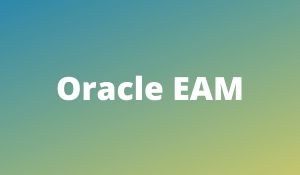
Oracle Enterprise Asset Management is part of Oracle’s E-Business Suite it deals with the comprehensive and routine asset maintenance requirements of asset-oriented organizations. Oracle EAM improves productivity with real-time analytics and lest the user on track with minute details. It lets the users monitor inventory with detail at all levels and also ensures the new inventory is ordered on time and prevents overstocking. It lets the user create libraries. Further, it gives its users a Robust Fleet management with which users can improve service and also ensures reliability
Things you will learn in this tutorial:
- Key Features of Oracle EAM
- Oracle EAM Support
- Setting up Oralce EAM
- Defining EAM parameters
- Limitations
Key Features of Oracle EAM
- Asset Lifecycle Management: This feature helps the user to align the value chain throughout the organization. Demand-driven spares reduce overstocking; maintenance management allows users to proactively perform routine maintenance on a set schedule; MRO materials can be organized and tracked, which keeps the stockrooms organized and ensures that they are present for use as per the need.
- Work Order Management: Users can assign, perform, complete, schedule, and close work orders through an extensive interface.
- Inventory Management: Users can effectively manage the flow of goods into and out of the warehouse. This includes the prevention of hazardous materials and also prevents shortages or costly ordering mistakes.
- Maintenance Management: It allows the users to implement a preventive maintenance program to improve efficiency and asset life-cycle including decreased downtime and fewer repairs.
- Vehicle Management: Dispatch, track, and communicate with a fleet of vehicles directly through Oracle’s asset management platform. Users can assign vehicles to the drivers and other equipment, track vehicles, and measure vehicle financial performance.
- Facilities Management: It lets the Users monitor both assets and facility maintenance tasks.
- Integrations: Oracle EAM integrates with every other Oracle E-Business Suite product such as
- Oracle ERP,
- Oracle IoT Asset Monitoring Cloud Service,
- Oracle Analytics Cloud, etc.
Oracle EAM Support
- Sustaining Support: The most basic package includes 24/7 service requests, major product updates, and access to the My Oracle Support system and Oracle blog.
- Extended Support: Includes all “Sustaining” features and also access to proprietary “Platinum” services.
- Premier Support: Includes all previous services with the addition of certification with most new third-party products, which allows wider integration capabilities.
Setting up Oracle EAM
Oracle Enterprise Asset Management will have unique setups for every organization, including user-defined lookups, attributes, and all the parameters. During the implementation process, the implementation team should discuss system parameters and user options for EAM. Users implementing EAM should also have determined the structure of their organizations or the company and user access via the Oracle System Administrator responsibility.
| Learn more information from the GoLogica “Oracle Enterprise Manager Cloud Control Training“ |
EAM Parameters
Indicate if the organization has system-generated asset numbers within individual asset groups.
Choose Event Log Controls to enable system events that are logged within the current organization. You can select the Log Enabled check box next to the events that you want logging for your assets.
The Cost Defaults region represents default cost information for future Work Orders, without defined cost elements within the work order.
The user is allowed to select an EAM Cost Element to show how to capture cost overheads any miscellaneous resource costs and other costs
The user is allowed to choose a Cost Category to use as the default for departments that do not have a cost category defined.
Indicate whether work requests are automatically approved upon creation, or if every user, with the responsibility assigned to the asset’s current owning department, receives a notification via Workflow
If the Auto Approve check box is selected, work requests are created with an Awaiting Work Order status. If the check box is not selected, work requests are created with an Open status.
Note: A work request status must be Awaiting Work Order before you can associate it with a Work Order. The Awaiting Work Order status indicates that the work request is approved.
Optionally select the Default Asset from the Employee Location check box to indicate the default asset information when creating a work request. If this check box is selected, the Asset Number information defaults as the Location number exported from Oracle Property Manager. Oracle Property Manager is a separate product.
A User can select the Asset Number Mandatory check box to mention that the Asset Number field is compulsory while creating a work request.
Limitations
Some of the product limitations include:
- The Oracle EAM is relatively expensive than other Asset Management tools
- It has limited usability for SMBs and is mostly suitable for large enterprises
- Oracle EAM is a solution that requires extensive training and IT support
- It provides only a limited set of reporting formats and analytics.
- Limited features in the Material Requisition/Procurement module when compared to other EAM solutions.
👉 Related Articles:



